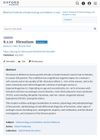Approach to Androgen Excess in Women: Clinical and Biochemical Insights
March 2022
in “
Clinical Endocrinology
”
androgen excess Polycystic ovary syndrome PCOS congenital adrenal hyperplasia CAH adrenocortical carcinoma ACC ovarian hyperthecosis OHT syndromes of severe insulin resistance SIR Cushing's disease virilizing ovarian tumours VOTs hirsutism acne alopecia GnRH analogue test short synacthen test ovarian venous sampling adrenal venous sampling GnRH test synacthen test ovarian sampling adrenal sampling

TLDR The document concludes that a systematic approach is crucial to identify causes of androgen excess in women beyond the most common cause, Polycystic ovary syndrome (PCOS).
The document "Approach to androgen excess in women: Clinical and biochemical insights" discusses the causes, symptoms, and diagnosis of androgen excess in women. The most common cause is Polycystic ovary syndrome (PCOS), affecting at least 10% of women. Other causes include congenital adrenal hyperplasia (CAH), adrenocortical carcinoma (ACC), ovarian hyperthecosis (OHT), syndromes of severe insulin resistance (SIR), Cushing's disease, and virilizing ovarian tumours (VOTs). Symptoms include hirsutism, acne, and alopecia. The document emphasizes the importance of careful clinical and biochemical phenotyping to identify patients at risk of non-PCOS pathology. Diagnostic approaches include the GnRH analogue test, short synacthen test, and ovarian and adrenal venous sampling. The document concludes that a systematic approach is needed to identify non-PCOS pathology.



















